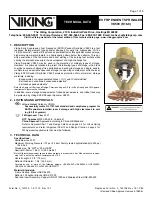
Argus Technologies Ltd.
030-692-C0 Rev A WC
Printed in Canada. © 2006 Argus Technologies Ltd. ARGUS is a registered trademark of Argus Technologies Ltd. All Rights Reserved.
Page 13 of 20
7 Initial
Start-up
Before making the final battery connection, perform the following start-up and test procedure to prevent damage
and ensure proper system operation:
1. Verify that cabling is installed correctly – refer to Sections 4-6. Record battery cell voltage readings if required
by the battery manufacturer.
2. Remove the supervisory module and verify that the two temperature compensation jumpers are set to the
appropriate level for the battery in the system. Consult with the battery vendor if necessary. Re-install the
supervisory module.
3. Ensure all power modules are removed from the rectifier shelf, all load fuses are removed and load circuit
breakers turned off.
4. Verify that battery voltage is approximately 51V indicating a fully charged/correctly connected battery string.
Verify that the battery polarity is correct using a voltmeter.
5. Install one power module.
6. Verify AC input voltage is correct and turn on AC input feeder breaker.
7. The module should turn on and the Green Power On and Red Fail LED’s will illuminate.
8. Turn on the battery circuit breaker(s).
NOTE:
If the system is not equipped with battery circuit breaker(s), then the rectifier float voltage should be
lowered to match the battery string voltage within 0.5V before the battery is connected to avoid sparks. This
final connection should be made at the battery for ease of access.
9. The Red Fail LED should turn off and system will begin charging batteries (if connected).
NOTE:
Without a battery or load on the system the rectifiers will continue to illuminate the Red Fail LED (see
Section 2.2.3 True Module Fail Alarm).
10. Install the remaining power modules.
11. Test functionality of various alarm settings, relays and controls refer to Section 8 to make any adjustments.
•
OVP, HVA, LVA and LVD settings can be checked by increasing or decreasing the test voltage on the
supervisory module and recording the voltage at which the appropriate LED illuminates. A voltmeter
connected to the test jacks is required to verify the voltage setting. Relay continuity should also be
verified.
•
AC failure, circuit breaker trip/fuse alarm, battery breaker trip, rectifier failure major and minor can be
verified by simulating the appropriate condition and checking relay continuity.
12. See Section 8.3.2. The rectifiers float voltage should also be adjusted to the voltage required by the battery
@ 25°C (77°F) and to “share” the current load evenly among multiple parallel modules as indicated on the
LED bar graph display.
13. Turn the temperature compensation switch on the supervisory module on.
Содержание RSM 48/10
Страница 1: ...RSM 48 10 Top Input Output 19 Shelf for 30A System 030 692 B2 ...
Страница 8: ...This page intentionally left blank ...
Страница 33: ......
Страница 34: ......
Страница 37: ......
















































